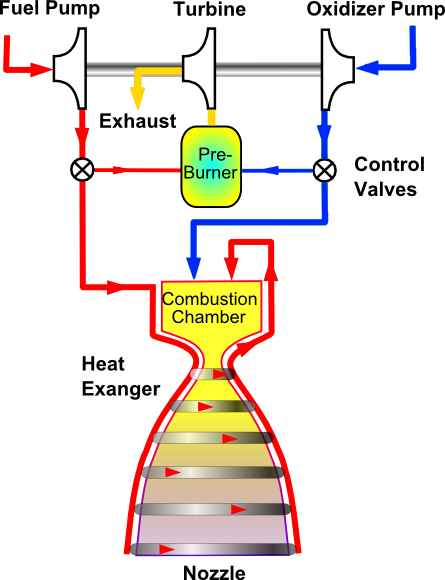Copyright 2015 Robert Clark
It is understandable that SpaceX wants to use the "hover-slam" approach, which allows no hovering capability, for their vertical landings of the Falcon 9 first stage. This means they would have to make no modifications to their rockets. However, it has always been taken as a given that vertical landing reusable launchers would have hovering capability:
Horizontal vs. vertical landing (Henry Spencer; Mitchell Burnside Clapp).
http://yarchive.net/space/launchers/horizontal_vs_vertical_landing.htmlIn the blog post "Hovering capability for the reusable Falcon 9", I suggested various attachments to the Merlin engine nozzles that could serve to give the first stage hovering ability. Here I'll suggest some methods that will provide different means of producing lower thrust from the engines.
The Merlin's are turbopump fed engines that use moderately high chamber pressures to produce high thrust. But what we want for the landing is actually low thrust. Then rather than using the turbopumps can we use the engines in a pressure-fed mode? The idea will be that during landing the propellant is presented to the engines using the pressurization from the tanks alone, bypassing the turbopumps.
This requires some care however. If you have additional piping that leads from the tanks directly into the engine combustion chambers bypassing the turbopumps, then you definitely can not have the turbopumps operating at the same time. The reason is the turbopumps will provide combustion at high pressure within the engines and the low pressure coming directly from the tanks would allow hot combustion gases to travel back up these lines into the propellant tanks.
Indeed, for all engines, pump-fed or pressure-fed, the pressure of the propellants from the piping into the engines is always significantly higher than the pressure within the combustion chamber. This is to ensure the combustion gases do not travel back up into the propellant tanks.
Another possibility is to just use the usual piping that goes into the turbopumps but insure the turbopumps are turned off during this mode. There are various types of operating cycles used in rocket engines however. Is the gas generator engine cycle used by the Merlins amenable to this mode where the turbopumps are not turning and the propellant is allowed to flow straight through from the tanks into the engine?
Gas-generator rocket cycle. Some of the fuel and oxidizer is burned separately to power the pumps and then discarded. Most gas-generator engines use the fuel for nozzle cooling.
There is also the question of how much thrust you can get at this low pressure. Typically for pump-fed engines, the propellant tanks are only held at pressure ranges of about 2 to 3 bar. Necessarily then the pressure within the combustion chamber would have to be even lower than this. You would then have the problem that the pressure in the combustion chamber would be only slightly higher than the surrounding air pressure at sea level, making it difficult to get net thrust. If it does work, likely you would need to use more than one Merlin for the landing, possibly all of them,
Another possibility for getting lower thrust would be to emulate the "thrust augmented nozzle" proposal of Aerojet. This works in analogous fashion to an afterburner for fighter jets. It would inject additional propellant into the nozzle to get higher thrust, so you have actual combustion going on both in the combustion chamber and in the nozzle.
A modification to this idea would be to just inject the fuel, not the oxidizer, into the nozzle. Since this is to be used just for landing you would have sufficient air for combustion. The advantage of this is that you would save on the total propellant required for the landing since the oxidizer would not be used.
Bob Clark
UPDATE, July 8, 2015:
If the Merlin can not be made to be pressure-fed, SpaceX does have a pressure-fed engine, the Kestrel. It was used on the upper stage of the Falcon 1. It had an approx. 3,000 kilogram-force vacuum thrust. Being an upper stage engine it would have reduced thrust at sea level.
Moreover, it was designed for the 200 psi tanks of the Falcon 1 upper stage. The Falcon 9 tanks, for the pump-fed Merlins, would be at lower pressure, perhaps in the 50 psi to 100 psi range. This would mean the thrust would be even further reduced.
For a ca. 15,000 kg dry mass F9 first stage you might need 8 to 10 of the Kestrel's with their reduced sea level thrust. The mass penalty would not be severe since they only weighed 52 kg. And they would weigh even less than this in this application since you would greatly reduce the nozzle size to operate at sea level. There is also the fact that for a first stage, extra mass added to the stage only subtracts a fraction of this added mass from the orbital payload capacity.






